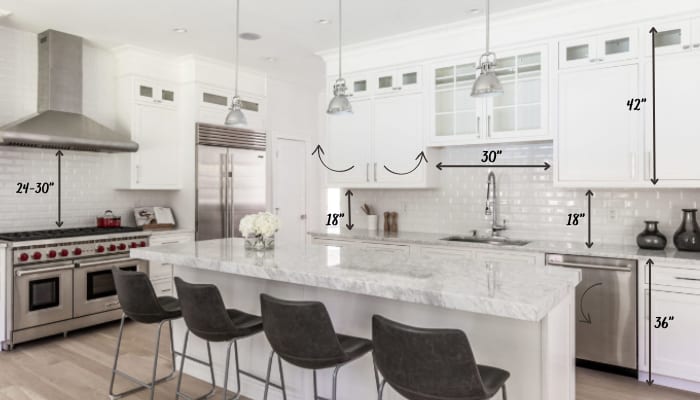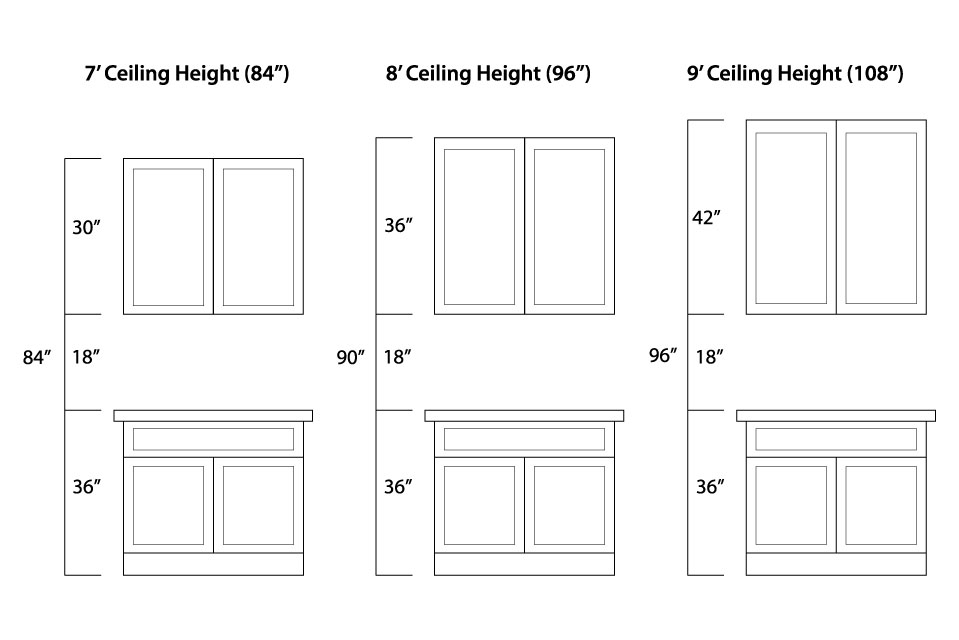The Importance of Standard Distance

The standard distance between countertops and upper cabinets is not merely a matter of aesthetics. It plays a crucial role in creating a kitchen that is both functional and comfortable to use. Maintaining this standard distance ensures that the space is ergonomically designed, promoting efficient workflow and minimizing user strain.
Ergonomic Benefits of Standard Distance
The standard distance between countertops and upper cabinets is generally recommended to be 18 inches (46 cm). This measurement is based on the average human height and arm reach, ensuring that the space is comfortable and accessible for most individuals. This optimal distance minimizes the need for excessive reaching or bending, which can lead to discomfort, fatigue, and potential injuries.
- Reduced Strain on Back and Neck: A standard distance allows users to comfortably reach items stored in upper cabinets without straining their back or neck. This is especially important for individuals who spend significant time in the kitchen, as it helps prevent chronic pain and discomfort.
- Improved Posture: The standard distance encourages users to maintain a more upright posture while working in the kitchen. This helps promote better circulation and reduces the risk of musculoskeletal problems.
- Enhanced Visibility: The optimal distance provides clear visibility of the countertop and surrounding areas, reducing the risk of accidents or spills.
Optimizing Workspace Efficiency, Standard distance between countertop and upper cabinets
The standard distance between countertops and upper cabinets significantly impacts the efficiency of the workspace. It creates a well-defined and accessible zone for food preparation and cooking.
- Increased Countertop Space: The standard distance maximizes usable countertop space by preventing upper cabinets from encroaching on the working area. This allows for ample room for food preparation, cooking, and other tasks.
- Improved Access to Cabinets: The optimal distance ensures easy access to upper cabinets, making it convenient to store and retrieve items. This reduces the time and effort required to reach items, enhancing the overall efficiency of the kitchen.
Potential Issues with Improper Spacing
Deviating from the standard distance can create various problems that impact the functionality and comfort of the kitchen.
- Bumping Heads: If upper cabinets are placed too low, there is a high risk of bumping heads, especially for taller individuals. This can lead to injuries and create a sense of claustrophobia.
- Difficulty Accessing Items: If upper cabinets are placed too high, it can become challenging and inconvenient to reach items, especially for shorter individuals or those with mobility limitations. This can result in wasted time and frustration.
- Uncomfortable Posture: Improper spacing can force users to adopt uncomfortable postures, such as hunching over or reaching too far. This can lead to muscle strain, fatigue, and potential injuries over time.
Standard Distance Guidelines

The standard distance between a countertop and upper cabinets is a crucial aspect of kitchen design, ensuring both functionality and comfort. This distance allows for sufficient headroom and clearance for tasks like cooking and preparing food, while also accommodating the height of common kitchen appliances.
Factors Influencing Standard Distance
The standard distance is determined by a combination of factors, including:
- Average Human Height: The average height of individuals in a given population plays a significant role in establishing a comfortable and functional kitchen space.
- Common Kitchen Appliance Sizes: The dimensions of appliances, such as refrigerators, ovens, and dishwashers, influence the required space for proper operation and access.
- Safety Considerations: Maintaining adequate clearance between the countertop and upper cabinets prevents head injuries and ensures easy access to items stored above.
Standard Distance in Inches and Centimeters
The generally accepted standard distance between a countertop and upper cabinets is:
| Unit | Distance |
|---|---|
| Inches | 18-21 inches |
| Centimeters | 45.72-53.34 centimeters |
Factors Affecting Distance: Standard Distance Between Countertop And Upper Cabinets

While the standard distance between countertops and upper cabinets offers a functional and comfortable baseline, individual preferences and kitchen layout considerations can influence the optimal distance.
Individual Preferences
Personal preferences play a significant role in determining the most comfortable countertop-to-cabinet distance. For instance, individuals with taller stature might prefer a greater distance to avoid bumping their heads, while shorter individuals might find a closer distance more convenient for reaching upper cabinets. Additionally, some individuals might prefer a greater distance for a more spacious feel, while others might prefer a closer distance for a cozier atmosphere.
Kitchen Layout
The layout of the kitchen also significantly impacts the optimal distance between countertops and upper cabinets. In kitchens with limited space, minimizing the distance can maximize usable space. For example, in a small galley kitchen, a closer distance between countertops and cabinets can create a more efficient and less cramped layout. Conversely, in larger kitchens, a greater distance can provide a more spacious and airy feel.
Scenarios Requiring Adjustment
Several scenarios may necessitate adjustments to the standard countertop-to-cabinet distance.
Tall Users
Tall individuals often require a greater distance to avoid bumping their heads against upper cabinets. A distance of 18-20 inches might be more comfortable for individuals over 6 feet tall.
Limited Kitchen Space
In kitchens with limited space, minimizing the distance between countertops and upper cabinets can maximize usable space. A distance of 15-16 inches might be more suitable in smaller kitchens.
Flowchart Illustrating Decision-Making Process
A flowchart can effectively illustrate the decision-making process for choosing the appropriate countertop-to-cabinet distance based on various factors.
- Start: Determine the desired countertop height.
- Consider Individual Preferences: Evaluate personal preferences regarding headroom and desired feel.
- Assess Kitchen Layout: Analyze available space and desired aesthetic.
- Determine Optimal Distance: Based on preferences and layout, select a distance that optimizes functionality and aesthetics.
- Adjustments: Consider adjustments for tall users or limited space.
- End: Choose the most suitable countertop-to-cabinet distance based on individual needs and kitchen layout.
Standard distance between countertop and upper cabinets – The standard distance between a countertop and upper cabinets is crucial for comfortable use, allowing enough space for movement and reaching. This same principle applies to bedroom cupboards, where the design and placement of shelves and drawers can significantly impact functionality.
For inspiration on modern bedroom cupboard ideas that maximize space and style, check out this helpful resource. Remember, just like in the kitchen, a well-planned bedroom cupboard will create a harmonious and efficient environment.
Just like the standard distance between a countertop and upper cabinets is crucial for comfortable movement, a well-designed half wall in your bedroom can create a sense of privacy and separation while still allowing light to flow through. A half wall, often featuring a stylish design, can be the perfect way to define a space within a room, much like the upper cabinets above your kitchen counter define the work zone.
Learn more about the benefits of a half wall in bedroom , and how to incorporate it seamlessly into your bedroom design.